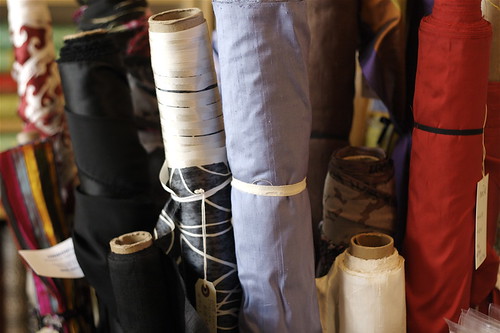Tips for Slippery Sewing
-- Melissa
Both the June and July issue of Burda Style are in the store. One of the things I appreciate about their approach to pattern drafting, is that they usually have "fashion fabric" in mind-- silk, wool, satin, jersey and even chiffon make appearances. Floaty cottons will remain my solid favourites, but lately I'm pushed to try and expand my fabric palette. I knee deep in knits at the moment but I'm moving towards the slippery stuff (silk, poly!) next.
There are a few things to keep in mind when you're sewing with silky textiles:
- Use tailors chalk to mark-- I get nervous cutting in notches with shifty fabric and certain marking pens bleed.
- Test out stitches and seams on small swatches.
- Use a new Universal or a Mictrotex/Sharp needle in your machine. A finer, sharper needle in your machine and a shorter stitch length are both going to prevent snagging and keep your stitches nice and tight. A larger needle can also occasionally jam the fabric down into the bobbin case, causing a mess of fabric and thread. When was the last time you changed your machine's needle? It's a good idea to change it up every two or three projects (depending on how much sewing they entailed).
- If you're having problems, increase the tension on your presser foot (check your machine's manual for directions). Sometimes the feed dogs and the presser foot have a hard time keeping up with lightweight fabrics. By tightening your foot, the top and bottom fabric will move at the same speed.
- If the stitching on my swatch is still all over the place, I turn to a tear away stablizer-- something like Sulky Lightweight (Bolt sells it in one yard packages). Follow the directions on the package and make sure you test it out first!

Hemming is my biggest beef with sheer and satiny fabrics. Nothing will stay where I want it to! The fold over and top stitch method usually makes for puckering and sad faces so that's out.
A Few Hemming Options:
- The most obvious one is to use a serger for a quick rolled hem or an overlocked edge. The rolled hem is done and good to go, where as the overlocked edge you might want to press under and hand tack using a blind stitch.
- Barring a serger, I often use polyester hem tape or overcast stitch. For the hem tape, I top stitch the tape on the right side of the raw edge of the hem. When that's done, I flip the taped edge under and hand stitch it down. For an overcast edge, you would use a long zig zag to finish the raw edge, and then flip it under once or twice (press and pin) and hand stitch it in place. Do you see the theme with the hand stitching? When you're pressing satin or silk, make sure you test on a swatch using a warm iron on the wrong side. Use a pressing cloth if you're not sure.
The bolt bins are too full of Fancies to be afraid to use them! Check out some of our magazines-- Ottobre and Burda specifically-- or look at our bins of independent pattern designers. Watch for the new Sew Liberated Sunday Picnic Blouse/Dress (coming soon!) or try out Anna Maria Horner's Evening Empire Dress in some of the new silks. It's easier than you might think.

